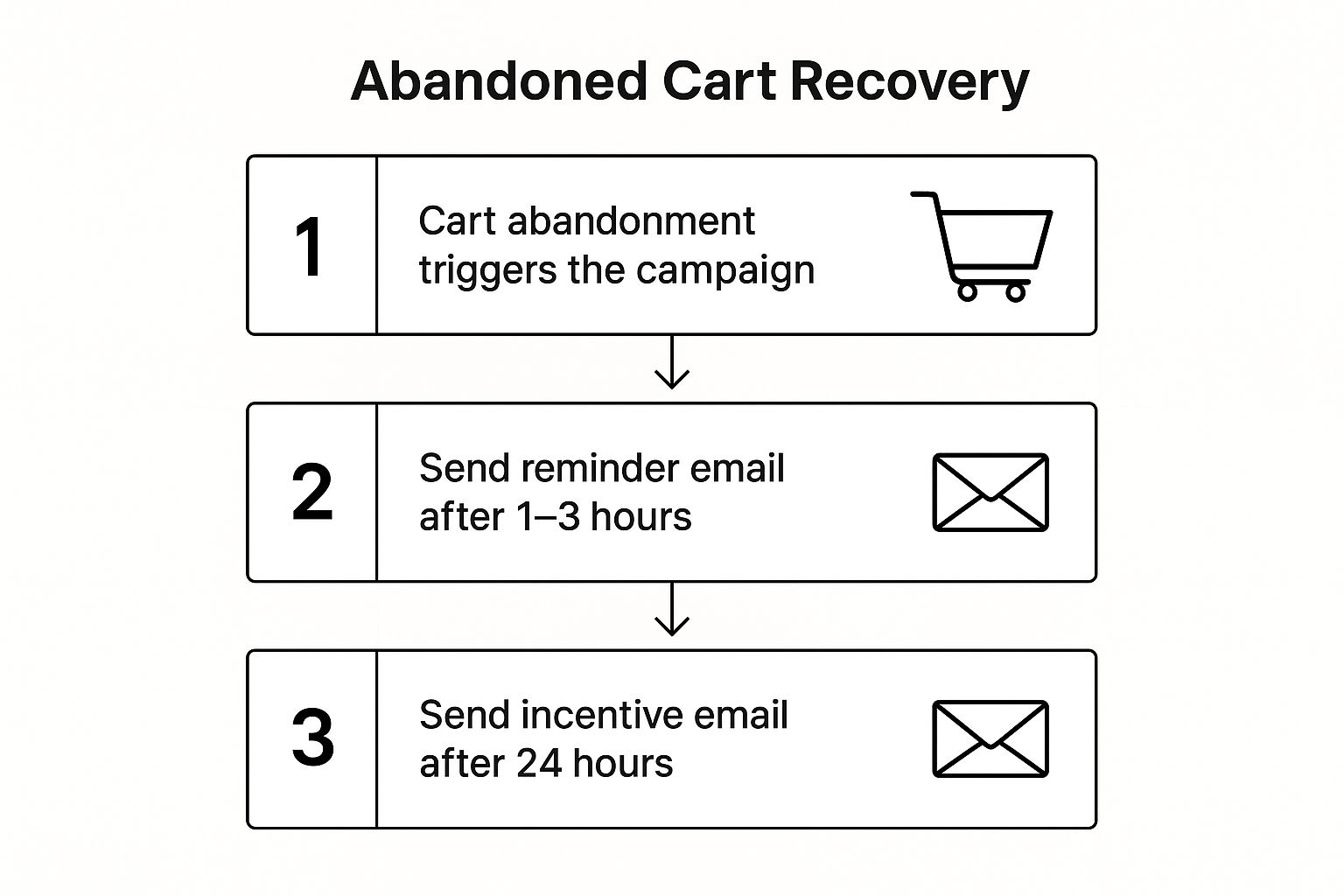Transforming Leads into Loyal Customers: A Deep Dive into Nurturing
Stop letting leads slip through the cracks. This listicle delivers seven powerful lead nurturing examples designed for door-to-door, event-based, and territory sales teams. Learn how LeadFlow Manager features can transform your lead management process, boost sales, and create lasting customer relationships. Discover the strategies top performers use to maximize their lead conversion rates. This article provides actionable insights and tactical breakdowns, showing you exactly why these examples work and how to replicate them for your own team. We'll cut the fluff and get straight to the practical application of these lead nurturing examples.
Specifically, you'll discover how to implement:
- Welcome Email Series
- Educational Content Drip Campaigns
- Abandoned Cart Recovery Campaigns
- Behavioral Trigger Campaigns
- Re-engagement Campaigns
- Lead Scoring and Progressive Nurturing
- Event-Based Nurturing Campaigns
These targeted strategies empower your team to move beyond simple lead capture. You'll gain a deeper understanding of cultivating leads, moving them efficiently through the sales pipeline, and turning them into loyal customers. Let's explore how LeadFlow Manager can empower your team to achieve significant growth.
1. Welcome Email Series
A welcome email series is a sequence of automated emails sent to new leads immediately after they sign up or express interest. This series introduces them to your brand, sets expectations for communication, and gradually guides them toward a purchase. It's a foundational lead nurturing example because it capitalizes on the initial high engagement period after a signup, establishing trust and providing value from the first interaction. For field sales teams, this translates to warming up leads before a rep even makes contact, significantly increasing the likelihood of a positive response.

Why Welcome Emails are Crucial for Lead Nurturing
A well-crafted welcome series serves several crucial purposes:
- First Impression: It sets the tone for your relationship with the lead.
- Education: It explains your services and how you can solve their problems.
- Value Delivery: Offers immediate value through tips, resources, or exclusive content.
- Segmentation: Helps segment leads based on their engagement with the emails.
This approach is especially beneficial for field sales organizations because it nurtures leads passively, allowing sales reps to focus on personalized outreach to those who have demonstrated initial interest. Think of it as pre-qualifying leads before your team invests valuable time in a phone call or in-person visit.
Examples of Effective Welcome Series
- Airbnb: Their welcome series introduces both host and guest experiences, demonstrating the platform's value proposition for both sides of the marketplace.
- Spotify: Onboarding emails highlight key features and guide new users toward personalized music discovery, encouraging continued platform use.
- Canva: Their welcome series showcases design templates and tutorials, providing immediate value and demonstrating the software’s ease of use.
These examples highlight how effective welcome series provide value while gently nudging leads towards conversion.
Actionable Tips for Creating a Winning Welcome Series
- Start Strong: Keep the first email simple, focused on delivering value, and confirming their signup.
- Strategic Timing: Space emails 2-3 days apart to avoid overwhelming leads.
- Build Trust: Include social proof and testimonials in later emails.
- Personalization: Tailor content based on the lead source or their expressed interests.
- Optimize: A/B test subject lines and send times to maximize open and click-through rates.
Utilizing LeadFlow Manager for Welcome Emails
For businesses using LeadFlow Manager, automating your welcome series becomes remarkably straightforward. The platform allows for automated email sequences triggered by lead capture, ensuring timely and consistent communication. This, in turn, frees up your field sales team to focus on high-value interactions, ultimately driving conversions and maximizing ROI. This powerful lead nurturing example ensures no lead falls through the cracks, maximizing your chances of converting early interest into closed deals.
2. Educational Content Drip Campaigns
Educational content drip campaigns nurture leads by delivering valuable, educational content over time. This positions your brand as a trusted authority and subtly introduces product solutions by focusing on solving prospects' problems with helpful information rather than direct selling. It’s a powerful lead nurturing example because it builds trust and credibility, fostering a stronger connection with potential customers. For field sales teams, this translates to warmer leads who are more receptive to a sales pitch when a rep finally makes contact.

Why Educational Content is Crucial for Lead Nurturing
Providing educational content serves several key purposes:
- Establishes Expertise: Showcasing your knowledge positions your brand as a leader in the industry.
- Builds Trust: Consistently providing valuable information cultivates trust and credibility.
- Long-Term Engagement: Keeps your brand top-of-mind throughout the buyer journey.
- Pre-Qualifies Leads: Educated leads are often better prepared for a sales conversation.
This is particularly beneficial for field sales organizations as it nurtures leads passively, allowing reps to concentrate on personalized outreach to more qualified prospects. This translates to more efficient use of their time and ultimately higher conversion rates.
Examples of Effective Educational Content Campaigns
- HubSpot: Their inbound marketing education provides valuable resources for marketers, establishing them as industry thought leaders.
- Salesforce: CRM best practice campaigns equip sales teams with knowledge, showcasing the power of their platform.
- Moz: SEO learning series attracts digital marketers seeking to improve their skills, naturally leading them to consider Moz's tools.
These examples demonstrate how educational content can effectively draw in leads and nurture them towards conversion.
Actionable Tips for Creating a Winning Educational Content Drip Campaign
- Buyer Journey Mapping: Align content with different stages of the buyer’s journey, addressing their evolving needs.
- Diversify Content Formats: Use blog posts, videos, infographics, and ebooks to cater to different learning preferences.
- Actionable Takeaways: Include practical tips and advice in every piece of content to provide immediate value.
- Subtle Product Integration: Gradually introduce product mentions as trust builds, demonstrating how your solutions can solve their problems.
- Performance Tracking: Monitor engagement metrics to identify the most effective content and optimize your campaigns.
Utilizing LeadFlow Manager for Educational Content Drip Campaigns
LeadFlow Manager streamlines the execution of educational content campaigns. The platform facilitates automated email sequences triggered by specific lead actions, ensuring timely and consistent content delivery. Learn more about Educational Content Drip Campaigns. This automation empowers your field sales team to focus on personalized interactions with informed, engaged leads, maximizing their effectiveness and boosting your ROI. This is a highly effective lead nurturing example, particularly for field sales teams managing a large volume of leads, as it ensures consistent and valuable communication throughout the sales cycle.
3. Abandoned Cart Recovery Campaigns
Abandoned cart recovery campaigns are targeted email sequences designed to re-engage potential customers who added items to their shopping cart but didn't complete the purchase. These campaigns address common barriers to purchase completion, such as unexpected shipping costs or simply distractions, and provide incentives like discounts or free shipping to encourage finalizing the transaction. This makes them a crucial lead nurturing example, especially for e-commerce businesses, but the principles can be applied to any field sales organization that utilizes online ordering or booking systems. For field sales teams, this translates to recovering lost opportunities and maximizing revenue from leads who have already demonstrated strong purchase intent.

The infographic above illustrates a simplified abandoned cart recovery process. It highlights the key steps: initial cart abandonment triggering the campaign, followed by a timely reminder email, and a subsequent incentive email. The visualization emphasizes the importance of quick follow-up and strategic incentives in recovering lost sales.
Why Abandoned Cart Recovery is Crucial for Lead Nurturing
Re-engaging leads who abandon their carts offers significant benefits:
- Revenue Recovery: Capitalizes on high-intent leads, increasing conversion rates and revenue.
- Improved ROI: Cost-effective way to recapture potentially lost sales with minimal effort.
- Enhanced Customer Experience: Provides helpful reminders and incentives, creating a positive brand perception.
- Data Insights: Offers valuable insights into customer behavior and potential areas for improvement in the sales process.
This is particularly advantageous for field sales teams as it allows for automated follow-up on online orders or bookings, freeing up reps to focus on in-person interactions and closing deals.
Examples of Effective Abandoned Cart Recovery
- Amazon: Their multi-touch email series includes product recommendations and reminds customers of items left in their cart.
- ASOS: This fashion retailer sends style-focused recovery emails showcasing similar items and current trends.
- Sephora: Their beauty-focused cart reminders include helpful makeup tutorials related to abandoned products.
- Wayfair: They send furniture cart recovery emails offering room inspiration and design ideas.
These examples highlight how effective campaigns provide value while gently encouraging customers to complete their purchases.
Actionable Tips for Creating a Winning Campaign
- Speed is Key: Send the first email within 1-3 hours of cart abandonment.
- Compelling Subject Lines: Create urgency and entice customers to open the email.
- Visual Appeal: Include high-quality product images to remind customers what they're missing.
- Helpful Assistance: Offer support and address potential concerns rather than just pushing for the sale.
- Strategic Incentives: Test different discount thresholds and free shipping offers to find what works best.
Utilizing LeadFlow Manager for Abandoned Cart Recovery
LeadFlow Manager streamlines abandoned cart recovery through automated email sequences triggered by specific customer actions within your online platform. This automation ensures timely follow-up and consistent messaging, maximizing your chances of converting abandoned carts into closed deals. This powerful lead nurturing example allows field sales teams to recapture potential revenue and optimize their overall sales performance.
4. Behavioral Trigger Campaigns
Behavioral trigger campaigns represent a dynamic approach to lead nurturing. These campaigns automatically respond to specific actions or behaviors exhibited by prospects, whether on your website, in emails, or during content interactions. This allows for highly relevant and timely messages based on demonstrated interest and engagement. For field sales, this translates to prioritizing leads showing buying signals, enabling reps to focus on the hottest prospects.
Why Behavioral Triggers are Crucial for Lead Nurturing
Behavioral triggers are powerful because they deliver the right message at the right moment. This personalized approach significantly increases engagement and conversion rates. Instead of generic email blasts, leads receive content tailored to their specific actions, demonstrating that you understand their needs and are ready to provide solutions. This is especially valuable for field sales teams, where personalized interactions are key to building trust and closing deals.
Examples of Effective Behavioral Trigger Campaigns
- Netflix: Their recommendation engine analyzes viewing behavior to suggest relevant content, keeping users engaged and subscribed. This personalized approach is a prime example of how behavioral triggers drive customer retention.
- LinkedIn: Triggers based on connection requests or profile views prompt outreach suggestions, facilitating networking and business opportunities. This encourages platform activity and provides value to users.
- Zillow: Property search behaviors trigger listing alerts, keeping potential buyers informed about new properties matching their criteria. This proactive approach helps nurture leads towards making offers.
These diverse examples highlight the versatility and effectiveness of behavioral triggers across different industries.
Actionable Tips for Creating Winning Behavioral Trigger Campaigns
- Prioritize High-Intent Behaviors: Focus on actions that indicate strong buying intent, such as pricing page visits or demo requests. This ensures that your sales team focuses on qualified leads.
- Set Frequency Caps: Avoid overwhelming prospects with too many emails. Implement frequency caps to maintain a balanced communication cadence. This respects the lead's time and prevents them from feeling bombarded.
- Progressive Profiling: Gather more data over time by triggering forms or surveys based on specific behaviors. This allows for increasingly personalized communication as you learn more about the lead.
- Test Trigger Thresholds: Experiment with different thresholds for triggering actions to optimize timing and maximize impact. This data-driven approach ensures your campaigns are as effective as possible.
Utilizing LeadFlow Manager for Behavioral Trigger Campaigns
LeadFlow Manager simplifies the implementation of behavioral trigger campaigns. Its automation features allow you to define specific triggers based on lead actions within the platform. This means that as leads interact with your content or website, LeadFlow Manager automatically assigns them to the appropriate nurture sequences, ensuring timely follow-up from your field sales team. This streamlines the lead nurturing process, freeing up your reps to concentrate on closing deals, making it a powerful lead nurturing example for any field sales organization.
